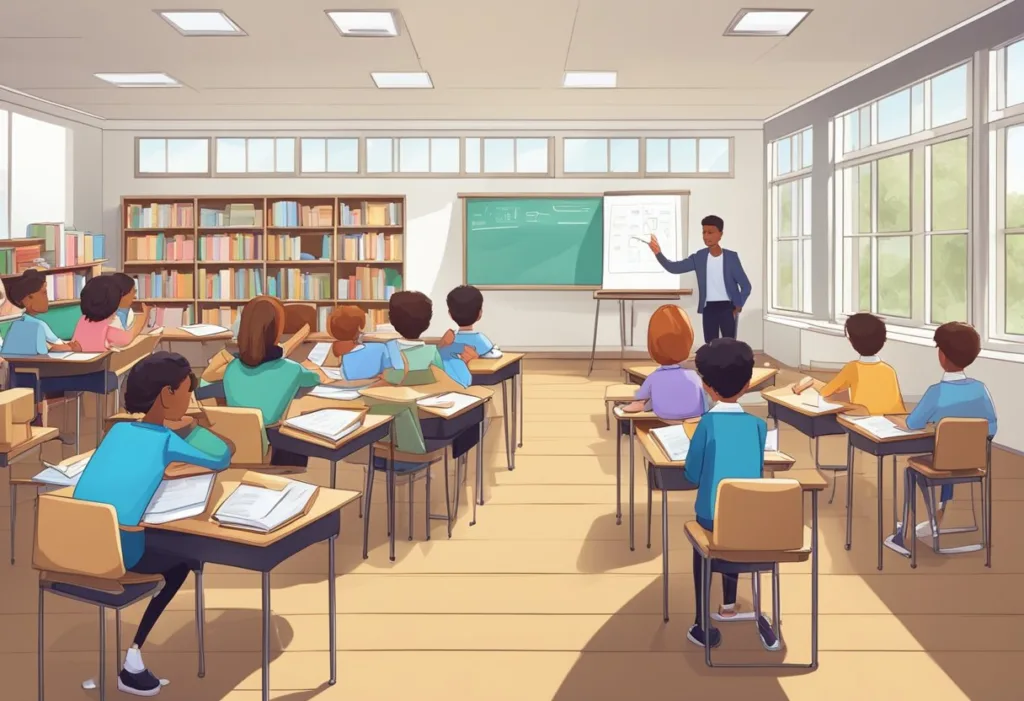Augmented reality (AR) is a rapidly growing technology that has the potential to revolutionize the way we learn and teach. AR is a type of technology that overlays digital information onto the real world, creating an interactive experience that enhances learning and engagement. With the increasing use of mobile technology, especially smartphones, among young Americans, AR has become more accessible and relevant in modern education. In this blog post, I will discuss the role and use cases of AR in education and how Augmented reality can benfit students and educators.
The role of AR in modern education is to create an immersive and interactive learning experience that engages students and enhances their understanding of complex concepts. AR can be used in various fields, such as professional training, science, and gaming. It has the potential to transform the way we teach and learn by providing a more engaging and interactive experience that can enhance learning outcomes in both K-12 and higher education settings.
The Role of AR in Modern Education
As technology continues to advance, the use of Augmented Reality (AR) in education has become increasingly popular. AR is a technology that overlays digital information onto the real world, creating an interactive experience for users. In modern education, AR has a significant role to play in enhancing student engagement, visualizing complex concepts, and differentiating between AR and Virtual Reality (VR).
Enhancing Student Engagement
One of the most significant advantages of AR in modern education is its ability to enhance student engagement. AR provides students with an interactive and immersive learning experience, which can help them stay focused and interested in the subject matter. AR can also be used to gamify the learning experience, making it more enjoyable and exciting for students.
Visualizing Complex Concepts
AR can be used to visualize complex concepts, making it easier for students to understand and retain information. For example, AR can be used to create 3D models of complex structures such as molecules or human organs, allowing students to interact with them in a way that is not possible with traditional teaching methods. This can help students to understand the concepts better and remember them for longer.
Augmented Reality vs. Virtual Reality
It is important to differentiate between AR and Virtual Reality (VR) when discussing their role in modern education. While both technologies can enhance the learning experience, they differ in their approach. AR overlays digital information onto the real world, while VR creates a completely digital environment. AR is more suitable for visualizing real-world objects and concepts, while VR is better suited for creating immersive digital experiences.
AR has a significant role to play in modern education, enhancing student engagement, visualizing complex concepts, and providing a unique learning experience. As technology continues to advance, it is likely that AR will become even more prevalent in education, providing students with an increasingly interactive and immersive learning experience.
Use cases for AR in education
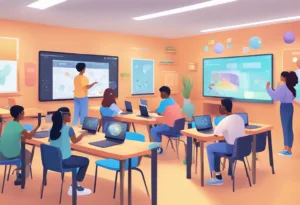
- Interactive Textbooks
- Virtual Field Trips
- Science Simulations
- Language Learning
- Historical Reconstruction
- Medical and Anatomy Education
- Art and Design Visualization
- Astronomy and Space Exploration
- Geographical Mapping
- Skills Training and Technical Education
Interactive Textbooks
Interactive textbooks revolutionize the traditional learning experience by embedding AR technology into educational materials. These textbooks come to life when viewed through a smartphone or tablet, displaying animated 3D models, videos, and interactive elements that supplement the written content.
This technology transforms passive reading into an engaging, interactive event, allowing students to visualize and interact with complex data and abstract concepts. For instance, a biology textbook might enable students to see a beating heart from various angles or a chemistry book could show molecules interacting in real-time, offering a more comprehensive understanding of the subject matter.
Virtual Field Trips
Virtual field trips are an innovative application of AR, allowing students to explore distant or inaccessible locations right from their classroom. Using AR headsets or mobile devices, learners can be transported to different environments, such as historical sites, natural wonders, or even outer space.
This immersive experience is not only captivating but also educational, as it provides context and real-world connections to the curriculum. Students can visit the pyramids of Egypt, the bottom of the ocean, or the surface of Mars, all without leaving their desks, breaking down the walls of the classroom to bring the world to the students.
Science Simulations
Science simulations using AR technology offer students a hands-on approach to understanding complex scientific principles. These simulations can demonstrate experiments that might be too dangerous, expensive, or impractical to perform in a traditional lab setting.
For example, students can witness chemical reactions at a molecular level or manipulate virtual electrical circuits to understand the flow of electricity. By interacting with these simulations, learners gain a deeper insight into scientific processes and theories, making the abstract tangible and easier to comprehend.
Language Learning
Language learning through AR can provide a highly immersive and interactive environment for students to practice new languages. AR applications can overlay text translations on objects in the real world, allowing learners to expand their vocabulary and improve their pronunciation.
AR can simulate real-life conversations with virtual characters, offering a safe space for students to practice speaking and listening skills. This contextual and conversational approach to language learning can accelerate the acquisition of a new language by making it more relevant and engaging.
Historical Reconstruction
Historical reconstruction with AR allows students to experience history like never before. By overlaying historical scenes onto the current environment, learners can visualize historical events, explore ancient civilizations, and understand the context of past societies. This immersive form of education brings history to life, making it more relatable and interesting for students. Whether it’s walking through a reconstructed battlefield or witnessing the signing of a significant treaty, AR can provide a powerful connection to historical studies.
Medical and Anatomy Education
Medical and anatomy education benefit greatly from AR technology by providing detailed and interactive visualizations of the human body. Medical students can explore layers of anatomical structures in 3D, gaining a clearer understanding of the relationship between different body systems. AR can also simulate surgical procedures, allowing students to practice and refine their skills in a risk-free environment. This level of detail and interactivity enhances the learning process for future healthcare professionals.
Art and Design Visualization
Art and design visualization with AR enables students to see their creations in a real-world context. Artists and designers can project their work onto physical spaces, experiment with different colors and textures, and make adjustments in real-time.
This application of AR not only streamlines the creative process but also allows for a more dynamic exploration of design principles. It can also be used to study and interact with famous artworks in a more engaging way, offering insights into the techniques and context of various pieces.
Astronomy and Space Exploration
Astronomy and space exploration are made more accessible through the use of AR in education. Students can hold the solar system in their hands, walk on the surface of different planets, and witness astronomical events up-close. This immersive experience ignites curiosity and inspires a greater interest in space science, providing a visual and interactive method for understanding the vastness and complexity of the universe.
Geographical Mapping
Geographical mapping with AR transforms the way students learn about geography and the environment. By overlaying data onto physical maps, learners can interact with topographical models, analyze climate changes, and understand geopolitical shifts. This technology can turn a simple map into a rich, interactive experience, helping students to grasp the intricacies of our world and the impact of human activities on the planet.
Skills Training and Technical Education
Skills training and technical education are enhanced by AR’s ability to provide a realistic practice environment. Students learning trades or technical skills can use AR to simulate real-world scenarios, practice procedures, and master techniques before applying them in actual work settings.
This application is particularly valuable for industries where hands-on experience is crucial, such as automotive repair, electrical work, or plumbing. AR provides a safe and controlled environment for learners to develop their skills and build confidence in their abilities.
Technological Foundations of AR in Education
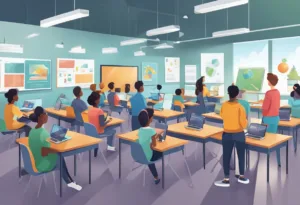
Augmented Reality (AR) technology has been increasingly used in education to enhance students’ learning experiences. This section will explore the technological foundations of AR in education, including understanding AR technology, hardware and software requirements, and smartphone integration.
Understanding AR Technology
AR technology is a type of mixed reality that superimposes digital information onto the physical world. AR can be experienced through various devices such as smartphones, tablets, and smart glasses. AR technology is based on computer vision, which allows the device to recognize and track the environment in real-time.
Hardware and Software Requirements
To use AR technology in education, hardware and software requirements must be met. The hardware requirements may vary depending on the device used, but generally, a device with a camera and a display is needed. In addition, the device must have enough processing power and memory to run AR applications smoothly.
On the software side, AR applications are needed to create and display AR content. AR applications can be developed using various programming languages such as Unity, JavaScript, and C#. AR applications can also be downloaded from app stores such as Google Play and the App Store.
Smartphone Integration
Smartphones are one of the most widely used devices for AR in education. To use AR on a smartphone, the device must have a camera and an AR application installed. Most modern smartphones meet these requirements, and there are many AR applications available for download. AR apps can be used in various subjects such as science, history, and art. For example, an AR app can be used to display 3D models of molecules in a science class or to bring historical artifacts to life in a history class.
AR technology has become an increasingly popular tool in education. To use AR in education, hardware and software requirements must be met, and AR applications must be installed. Smartphones are one of the most widely used devices for AR in education due to their accessibility and availability of AR applications.
Curriculum Integration and Development

Incorporating AR into Science Education
AR can be used to enhance science education by providing a visual representation of complex concepts and processes. For instance, AR can be used to display graphics of human body parts and functions, allowing students to interact with them in a more engaging manner. Biology students can use AR to visualize complex biological processes, such as photosynthesis or cell division, which are difficult to understand with textbooks alone.
Exploring History with AR
AR can be a valuable tool for exploring historical events and sites. With AR, students can visit historical sites and interact with virtual objects and characters, allowing them to experience history in a more immersive way. For example, students can use AR to explore ancient ruins, paintings, and sculptures, and learn about their significance in history.
AR in Art and Culture Learning
AR can also be used to enhance art and culture learning. AR can be used to display 3D models of paintings and sculptures, allowing students to view them from different angles and perspectives. AR can be used to create interactive art installations, where students can interact with virtual objects and characters in real-time. This can help students to develop a deeper understanding of art and culture.
AR has the potential to revolutionize education by providing a more immersive and engaging learning experience. By incorporating AR into science education, exploring history with AR, and using AR in art and culture learning, students can develop a deeper understanding of complex concepts and processes.
Interactive Learning through AR
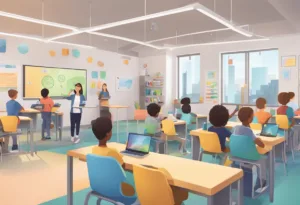
Augmented Reality (AR) technology has opened up new avenues for interactive learning in education. By combining digital content with the real world, AR enables students to learn in a more engaging and immersive way. In this section, we will discuss two key ways in which AR enhances interactive learning: Collaborative Learning Environments and 3D Models and Simulations.
Collaborative Learning Environments
AR technology allows students to work together in collaborative learning environments. By using AR-enabled devices, students can interact with digital content in real-time, enabling them to work together on projects, share ideas and learn from each other. This type of active learning is particularly effective in promoting engagement and collaboration among students.
3D Models and Simulations
AR technology also enables the creation of 3D models and simulations that allow students to explore complex concepts in a more interactive way. For example, AR can be used to create 3D models of molecules, planets, and other objects that students can manipulate and explore. This type of active learning helps students to better understand complex concepts and retain information.
AR is also an effective tool for creating simulations that allow students to explore real-world scenarios in a safe and controlled environment. For example, AR can be used to simulate medical procedures or disaster scenarios, allowing students to practice and refine their skills in a risk-free environment.
AR technology has the potential to revolutionize the way we learn by making education more engaging, interactive, and immersive. By creating collaborative learning environments and enabling the creation of 3D models and simulations, AR enhances the learning experience and helps students to better understand complex concepts.
AR in Specialized Training
Augmented Reality (AR) is a technology that has been revolutionizing the way we learn and train. AR has found its way into specialized training, such as medical, military, and engineering education. This technology has been used to enhance the training experience, providing a more interactive and immersive learning environment.
Medical and Healthcare Education
AR has been used in medical and healthcare education to provide medical students with a more realistic experience. Medical students can use AR to simulate surgeries and procedures, which can help them to better understand the procedure before they perform it on a real patient. AR can also be used to provide a more interactive and engaging learning experience for medical students. By using AR, medical students can visualize the human body in 3D, which can help them to better understand the anatomy and physiology of the human body.
Military and Engineering Applications
AR has also found its way into military and engineering education. In the military, AR can be used to simulate combat scenarios and provide soldiers with a more realistic training experience. AR can also be used to simulate different environments, such as deserts or forests, which can help soldiers to better prepare for different situations.
In engineering education, AR can be used to simulate different scenarios and provide students with a more realistic experience. For example, AR can be used to simulate a construction site, which can help engineering students to better understand the construction process and identify potential problems before they occur.
AR has tremendous potential in specialized training, providing a more immersive and interactive learning experience. As the technology continues to evolve, we can expect to see more applications of AR in professional training, such as healthcare, military, and engineering.
Assessment of AR Learning Tools
As educational institutions continue to integrate augmented reality (AR) into their curriculum, it is essential to evaluate the effectiveness of AR learning tools. The following subsections provide an overview of how to evaluate educational software and the effectiveness of AR in improving learning outcomes.
Evaluating Educational Software
When evaluating AR learning tools, it is crucial to consider the quality of the AR overlays and digital information presented to the learner. The AR overlays should be accurate, relevant, and engaging to the learner. Educational software should also be user-friendly, intuitive, and accessible to learners of all skill levels.
One way to evaluate educational software is to use a rubric that assesses the software’s quality, usability, and effectiveness. This rubric should include criteria such as the accuracy and relevance of the AR overlays, the software’s ease of use, and the software’s ability to improve learning outcomes.
Effectiveness and Learning Outcomes
Several studies have shown that AR can be an effective tool for improving learning outcomes. For instance, a meta-analysis of quasi-experimental studies conducted by Wu et al. (2013) found that AR significantly improved learning outcomes in various subject areas.
Another study by Su et al. (2022) suggested that AR can enhance the learning experience by providing a more immersive and engaging environment. However, it is essential to note that the effectiveness of AR learning tools depends on various factors, such as the quality of the AR overlays and the instructional design of the software.
Evaluating AR learning tools is crucial to ensure that they are effective in improving learning outcomes. Educational software should be evaluated based on criteria such as quality, usability, and effectiveness. AR has shown promising results in enhancing the learning experience, but its effectiveness depends on several factors.
Challenges and Considerations
When implementing AR in education, there are several challenges and considerations that need to be taken into account. Two of the most significant challenges are cost analysis and accessibility, as well as technical limitations and user experience.
Cost Analysis and Accessibility
One of the main challenges of implementing AR in education is the cost analysis. The cost of AR devices and software can be quite high, which may make it difficult for schools and educational institutions to adopt this technology.
However, there are cost-effective solutions available that can help schools and institutions to implement AR technology without breaking the bank. For example, some AR apps can be downloaded for free or at a low cost, and some devices, such as smartphones and tablets, can be used to access AR content.
Another consideration is accessibility. Not all students may have access to the necessary devices or equipment to use AR technology. To address this issue, schools and institutions can consider providing access to AR devices and software in libraries or computer labs. Schools can explore the use of BYOD (Bring Your Own Device) policies, which allow students to use their own devices to access AR content.
Technical Limitations and User Experience
Another challenge of implementing AR in education is the technical limitations and user experience. AR technology is still in its early stages and there are limitations to what it can do. For example, some AR apps may not work well in certain lighting conditions or may require a specific type of device to function properly.
In addition to technical limitations, user experience is also a consideration. AR can be a highly immersive and engaging experience, but it can also be overwhelming for some students. It is important to ensure that the use of AR in education is focused and aligned with the learning objectives. This means that educators need to carefully consider the use cases of AR in the classroom and ensure that it is being used to enhance the learning experience rather than distract from it.
While AR technology offers exciting possibilities for education, there are challenges and considerations that need to be taken into account. By carefully considering the cost analysis, accessibility, technical limitations, and user experience, educators can ensure that the use of AR in education is focused and effective.
Future Trends in AR Education
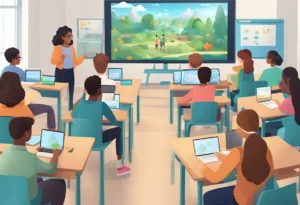
Extended Reality (XR) and Mixed Reality (MR)
XR and MR are the future of AR education. XR is an umbrella term that encompasses all immersive technologies, including AR, VR, and MR. MR, on the other hand, is a blend of AR and VR, which combines the best of both worlds. With XR and MR, students can learn in a more interactive and engaging environment, which helps them to retain information better.
The use of XR and MR in education is still in its infancy, but it is expected to become more prevalent in the coming years. In fact, according to a report by MarketsandMarkets, the XR market is projected to reach $20.9 billion by 2025. This growth is expected to be driven by the increasing demand for immersive technologies in education, among other industries.
Advancements in AR Visualization and Prototyping
AR visualization and prototyping are also expected to play a significant role in the future of AR education. With advancements in AR technology, students can now visualize complex concepts in a more intuitive and interactive way. For instance, they can use AR to explore the human body in 3D, which helps them to understand anatomy better.
AR prototyping, on the other hand, allows students to create and test their designs in a virtual environment before they are built in the real world. This not only saves time and resources but also allows students to experiment with different ideas and concepts without any consequences.
The future of AR education looks bright, with XR and MR, and advancements in AR visualization and prototyping expected to play a significant role. As technology continues to evolve, we can expect to see more innovative ways of using AR in education, which will help to transform the way we learn and teach.
Frequently Asked Questions
What is an AR study?
An AR study is a study that uses augmented reality technology to enhance the learning experience. It allows students to interact with digital objects and information in a real-world environment. AR studies can be used in a variety of subjects, from history to science, and can help students gain a deeper understanding of complex concepts.
What is AR class?
An AR class is a classroom that uses augmented reality technology to enhance the learning experience. It allows students to interact with digital objects and information in a real-world environment. AR classes can be used in a variety of subjects, from math to language arts, and can help students engage with the material in a more meaningful way.
What does AR mean in training?
AR in training refers to the use of augmented reality technology to enhance the training experience. It allows trainees to interact with digital objects and information in a real-world environment, making the training more engaging and effective. AR can be used in a variety of training scenarios, from military simulations to medical training.
What is AR used for?
AR is used for a variety of purposes, including education, training, entertainment, and marketing. In education, AR can be used to enhance the learning experience and engage students in a more meaningful way. In training, AR can be used to enhance the training experience and make it more effective. In entertainment, AR can be used to create immersive experiences for users. In marketing, AR can be used to create interactive advertisements and product demonstrations.
What is an example of AR?
An example of AR is the use of a smartphone app that overlays digital information onto the real world. For example, an AR app could be used to display information about historical landmarks as a user walks around a city. Another example is the use of AR in gaming, where digital objects are overlaid onto the real world to create an immersive gaming experience.
What are the two main types of AR?
The two main types of AR are marker-based AR and markerless AR. Marker-based AR uses a physical marker, such as a QR code, to trigger the display of digital information. Markerless AR uses computer vision technology to recognize and track real-world objects, allowing digital information to be overlaid onto the real world without the need for a physical marker.
What is an example of AR in the workplace?
An example of AR in the workplace is the use of AR technology to assist workers in performing complex tasks. For example, an AR headset could be used to guide a worker through the steps of assembling a complicated piece of machinery. AR can also be used in maintenance and repair, allowing workers to access digital information and instructions in real-time as they work.

